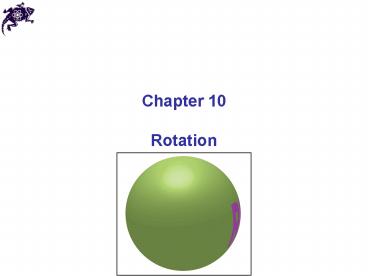Rotation - PowerPoint PPT Presentation
1 / 35
Title:
Rotation
Description:
... a constant acceleration) we can derive a set of formulas (Table 10-1) ... More information at: http://scienceworld.wolfram.com/physics/MomentofInertia.html ... – PowerPoint PPT presentation
Number of Views:335
Avg rating:5.0/5.0
Title: Rotation
1
Chapter 10 Rotation
2
- Rotation of a rigid body
- We consider rotational motion of a rigid body
about a fixed axis - Rigid body rotates with all its parts locked
together and without any change in its shape - Fixed axis it does not move during the rotation
- This axis is called axis of rotation
- Reference line is introduced
3
- Angular position
- Reference line is fixed in the body, is
perpendicular to the rotation axis, intersects
the rotation axis, and rotates with the body - Angular position the angle (in radians or
degrees) of the reference line relative to a
fixed direction (zero angular position)
4
- Angular displacement
- Angular displacement the change in angular
position. - Angular displacement is considered positive in
the CCW direction and holds for the rigid body as
a whole and every part within that body
5
- Angular velocity
- Average angular velocity
- Instantaneous angular velocity the rate of
change in angular position
6
- Angular acceleration
- Average angular acceleration
- Instantaneous angular acceleration the rate of
change in angular velocity
7
- Rotation with constant angular acceleration
- Similarly to Chapter 2 (case of 1D motion with a
constant acceleration) we can derive a set of
formulas (Table 10-1)
8
Chapter 10 Problem 6
9
- Relating the linear and angular variables
position - For a point on a reference line at a distance r
from the rotation axis - ? is measured in radians
10
- Relating the linear and angular variables speed
- ? is measured in rad/s
- Period (recall Ch. 4)
11
- Relating the linear and angular variables
acceleration - a is measured in rad/s2
- Centripetal acceleration (Ch. 4)
12
- Rotational kinetic energy
- We consider a system of particles participating
in rotational motion - Kinetic energy of this system is
- Then
13
- Moment of inertia
- From the previous slide
- Defining moment of inertia (rotational inertia)
as - We obtain for rotational kinetic energy
14
- Moment of inertia rigid body
- For a rigid body with volume V and density ?(V)
we generalize the definition of a rotational
inertia - This integral can be calculated for different
shapes and density distributions - For a constant density and the rotation axis
going through the center of mass the rotational
inertia for 9 common body shapes is given in
Table 10-2 (next slide)
15
Moment of inertia rigid body
16
- Moment of inertia rigid body
- The rotational inertia of a rigid body depends
on the position and orientation of the axis of
rotation relative to the body - More information at http//scienceworld.wolfram.
com/physics/MomentofInertia.html
17
- Parallel-axis theorem
- Rotational inertia of a rigid body with the
rotation axis, which is perpendicular to the xy
plane and going through point P - Let us choose a reference frame, in which the
center of mass coincides with the origin
18
Parallel-axis theorem
19
Parallel-axis theorem
20
Chapter 10 Problem 39
21
- Torque
- We apply a force at point P to a rigid body that
is free to rotate about an axis passing through O - Only the tangential component Ft F sin f of
the force will be able to cause rotation
22
- Torque
- The ability to rotate will also depend on how
far from the rotation axis the force is applied - Torque (turning action of a force)
- SI unit Nm (dont confuse with J)
23
- Torque
- Torque
- Moment arm r- r sinf
- Torque can be redefined as
- force times moment arm
- t F r-
24
- Newtons Second Law for rotation
- Consider a particle rotating under the influence
of a force - For tangential components
- Similar derivation for rigid body
25
Chapter 10 Problem 51
26
- Rotational work
- Work
- Power
- Work kinetic energy theorem
27
Corresponding relations for translational and
rotational motion (Table 10-3)
28
Answers to the even-numbered problems Chapter
10 Problem 2 14 rev
29
- Answers to the even-numbered problems
- Chapter 10
- Problem 10
- 30 s
- (b) 1.8 103 rad
30
- Answers to the even-numbered problems
- Chapter 10
- Problem 22
- 3.0 rad/s
- (b) 30 m/s
- (c) 6.0 m/s2
- (d) 90 m/s2
31
- Answers to the even-numbered problems
- Chapter 10
- Problem 36
- 7.1
- (b) 64
32
- Answers to the even-numbered problems
- Chapter 10
- Problem 46
- 8.4 N m
- (b) 17 N m
- (c) 0
33
Answers to the even-numbered problems Chapter
10 Problem 50 1.28 kg m2
34
- Answers to the even-numbered problems
- Chapter 10
- Problem 64
- 0.15 kg m2
- (b) 11 rad/s
35
- Answers to the even-numbered problems
- Chapter 10
- Problem 78
- 1.57m/s2
- 4.55 N
- (c) 4.94 N































